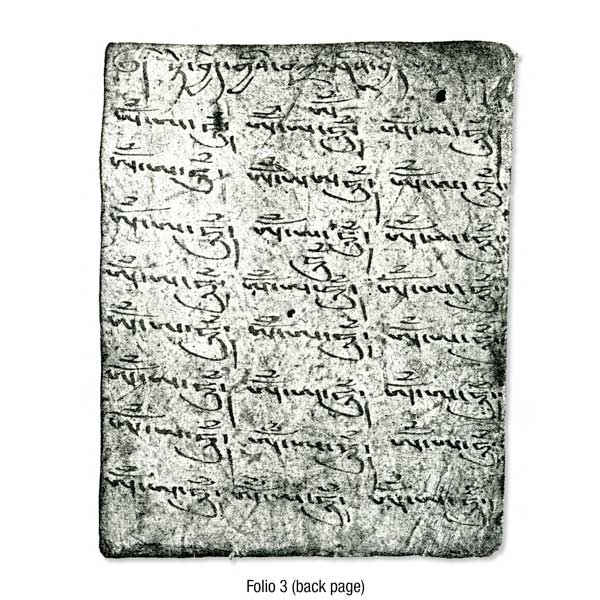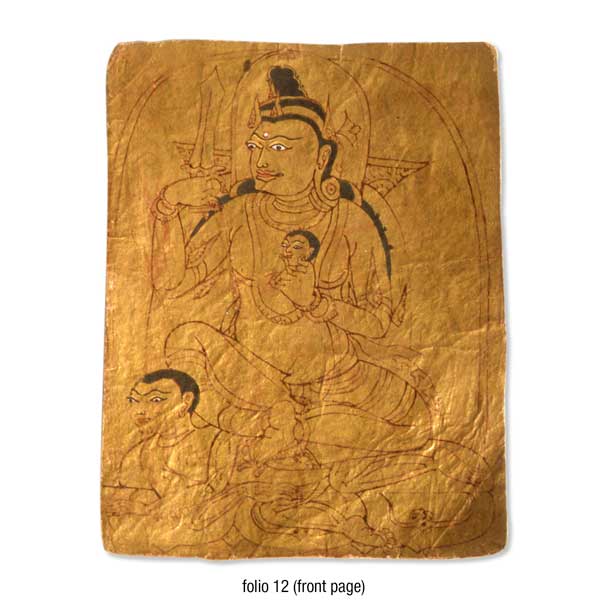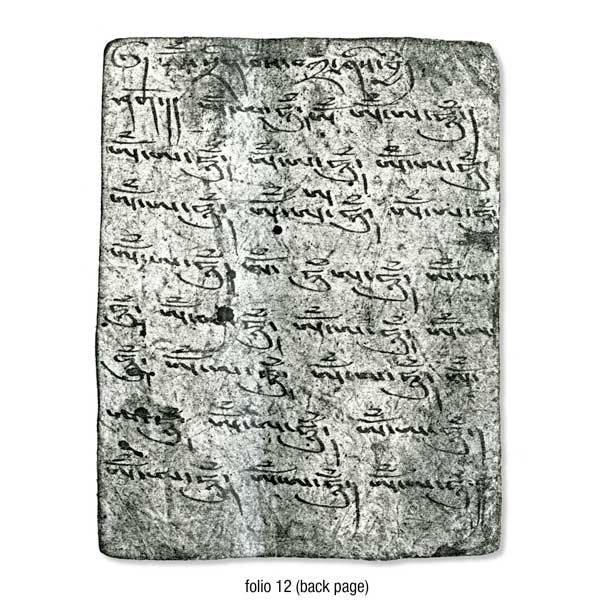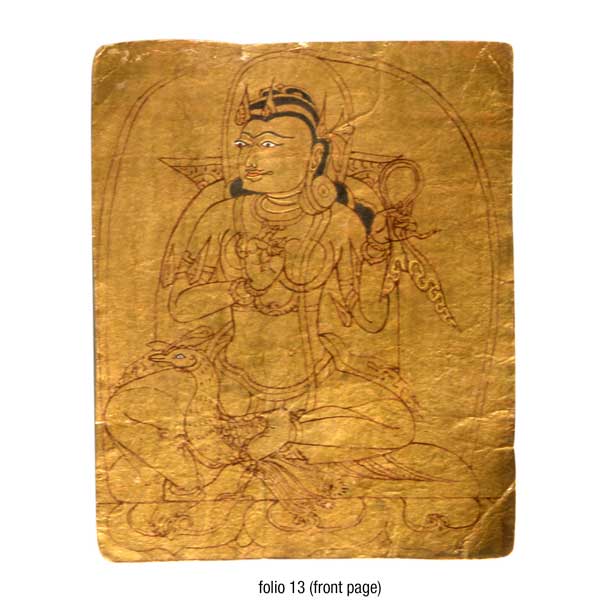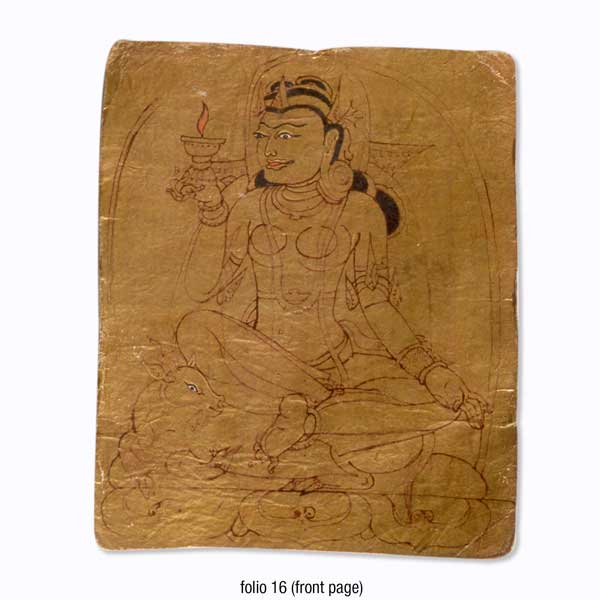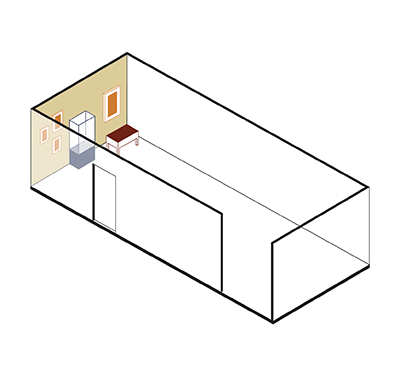ABM 011
Code: ABM 011
Country: Tibet
Style:
Date: 1250 - 1300
Dimensions in cm WxHxD: 8 x 10
Materials: Buff paper
Golden Tsa ka li ("tsakli") initiation card depicting a deity of the Sarvadurgatiparisodhana Tantra
Ink and gold foil on buff paper.
On the back side are Tibetan invocations and mantras in dBu med script. These three Tsa ka li are part of a larger serie of which some are in the collection of the Newark Museum (94.221.1-3) and various Private Collections. One of the Tsa ka li in the collection of the Newark Museum (94.221.3) depicts according to the inscription Sangs rgyas yar byon (1203-1272) (BA: 307, 650-2) the third abbot of the sTag lung monastery. This inscription is signed by his nephew, one of his disciples, Grags pa pal ozer zang po (1251-1296).
Folio A. 1/32: bDe byed (Skt: Sankara) (inscribed: bDe byed)
N° 168 of the 37-Principal Deity Sarvavid Vairocana Mandalabased on the Sarvadurgatiparisodhana Tantra.
Folio A. 3/32: gShin rje (Skt: Yama) (inscribed: gShin rje)
N° 113 of the 37-Principal Deity Sarvavid Vairocana Mandalabased on the Sarvadurgatiparisodhana Tantra.
Folio A. 5/32 : Nyi ma (Skt: Aditya [Surya]) (inscribed: Nyi ma)
N° 162 or 166 of the 37-Principal Deity Sarvavid Vairocana Mandalabased on the Sarvadurgatiparisodhana Tantra.
Folio D. 7/32 : Lha mtshams (Skt. Anuradha) (inscribed: Lha'tshams)(?)
N° 130 (?) of the 37-Principal Deity Sarvavid Vairocana Mandalabased on the Sarvadurgatiparisodhana Tantra.
Folio D. 9/32: Tshang ma (?) (Skt. Brahmani) (incribed: obliterated)
N° ? of the 37-Principal Deity Sarvavid Vairocana Mandalabased on the Sarvadurgatiparisodhana Tantra.
Folio D. 11/32: Nam gru (Skt: Revati) (inscribed: Nam gru)
N° 148 of the 37-Principal Deity Sarvavid Vairocana Mandalabased on the Sarvadurgatiparisodhana Tantra.
(Folio D.7, D.9, D.11 Collection Jesse Wolfgang, Geneva)
Folio 13/32: Cakra (Tib. Khor lo ma) (inscribed indBu med script: zhabs la (feet) 'khor lo (cakra)
Folio 15/32: Unidentified four-armed form of Avalokitesvara (?) not inscribed
Folio 17/32: Kalasi (tib. Bum pa ma) (inscribed in dBu medscript: mgur(song) la bum pa (vase).
13 and 17 depict two of the "eight auspicious objects" (astamangala) (Tib. bKra shis rtags brgyad), which comprise the weel (cakra), parasol (chattra), banner (dhvaja), water jar (kalasa), pair of fish (matsyayugma), lotus flower (padma), conch (sankha), and the endless knot (srivatsa).
Folio B. 21/32: Phur bu (Skt. Brhaspati) (inscribed: Pur bu)
N° 116 of the 37- Principal Deity Sarvavid Vairocana Mandala based on the Sarvadurgatiparisodhana Tantra.
Folio B. 23/32: srin po (Skt. Raksasa) (inscribed: Srin po)
N°156 of the 37- Principal Deity Sarvavid Vairocana Mandala based on the Sarvadurgatiparisodhana Tantra.
Folio B. 25/32: Me bzhi (Skt. Hasta) (inscribed: Me bzhi)
N° 121 of the 37- Principal Deity Sarvavid Vairocana Mandala based on the Sarvadurgatiparisodhana Tantra.
Folio C 27/32: mChu (Skt: Magha(inscribed: MChu)
N° 118 of the 37- Principal Deity Sarvavid Vairocana Mandala based on the Sarvadurgatiparisodhana Tantra.
Folio C 29/32: Sa ga (Skt: Visakha) (inscribed: Sa ka)
N° 124 of the 37- Principal Deity Sarvavid Vairocana Mandala based on the Sarvadurgatiparisodhana Tantra.
Folio C 31/32: Nag pa (Skt: Citra) (inscribed: Nag pa)
N° 122 of the 37- Principal Deity Sarvavid Vairocana Mandala based on the Sarvadurgatiparisodhana Tantra.
(Folio C.27, C.29, C.31 Collection Charles Julmy, Geneva)
The sTag lung monastery, also known as dPal sTag lung thang was founded in 1180 by sTag lung thang pa bKra shis dpal (1142-1210). Seat of the sTag lung pa bKa' brgyud. 'Phags chu valley; Byang district. Central Tibet (dBus). It can be assumed that this set of tsa ka li was painted in the 2nd half of the 13th century, possibly at the request of Grags pa pal ozer zang po (1251-1296).
Ink and gold foil on buff paper.
On the back side are Tibetan invocations and mantras in dBu med script. These three Tsa ka li are part of a larger serie of which some are in the collection of the Newark Museum (94.221.1-3) and various Private Collections. One of the Tsa ka li in the collection of the Newark Museum (94.221.3) depicts according to the inscription Sangs rgyas yar byon (1203-1272) (BA: 307, 650-2) the third abbot of the sTag lung monastery. This inscription is signed by his nephew, one of his disciples, Grags pa pal ozer zang po (1251-1296).
Folio A. 1/32: bDe byed (Skt: Sankara) (inscribed: bDe byed)
N° 168 of the 37-Principal Deity Sarvavid Vairocana Mandalabased on the Sarvadurgatiparisodhana Tantra.
Folio A. 3/32: gShin rje (Skt: Yama) (inscribed: gShin rje)
N° 113 of the 37-Principal Deity Sarvavid Vairocana Mandalabased on the Sarvadurgatiparisodhana Tantra.
Folio A. 5/32 : Nyi ma (Skt: Aditya [Surya]) (inscribed: Nyi ma)
N° 162 or 166 of the 37-Principal Deity Sarvavid Vairocana Mandalabased on the Sarvadurgatiparisodhana Tantra.
Folio D. 7/32 : Lha mtshams (Skt. Anuradha) (inscribed: Lha'tshams)(?)
N° 130 (?) of the 37-Principal Deity Sarvavid Vairocana Mandalabased on the Sarvadurgatiparisodhana Tantra.
Folio D. 9/32: Tshang ma (?) (Skt. Brahmani) (incribed: obliterated)
N° ? of the 37-Principal Deity Sarvavid Vairocana Mandalabased on the Sarvadurgatiparisodhana Tantra.
Folio D. 11/32: Nam gru (Skt: Revati) (inscribed: Nam gru)
N° 148 of the 37-Principal Deity Sarvavid Vairocana Mandalabased on the Sarvadurgatiparisodhana Tantra.
(Folio D.7, D.9, D.11 Collection Jesse Wolfgang, Geneva)
Folio 13/32: Cakra (Tib. Khor lo ma) (inscribed indBu med script: zhabs la (feet) 'khor lo (cakra)
Folio 15/32: Unidentified four-armed form of Avalokitesvara (?) not inscribed
Folio 17/32: Kalasi (tib. Bum pa ma) (inscribed in dBu medscript: mgur(song) la bum pa (vase).
13 and 17 depict two of the "eight auspicious objects" (astamangala) (Tib. bKra shis rtags brgyad), which comprise the weel (cakra), parasol (chattra), banner (dhvaja), water jar (kalasa), pair of fish (matsyayugma), lotus flower (padma), conch (sankha), and the endless knot (srivatsa).
Folio B. 21/32: Phur bu (Skt. Brhaspati) (inscribed: Pur bu)
N° 116 of the 37- Principal Deity Sarvavid Vairocana Mandala based on the Sarvadurgatiparisodhana Tantra.
Folio B. 23/32: srin po (Skt. Raksasa) (inscribed: Srin po)
N°156 of the 37- Principal Deity Sarvavid Vairocana Mandala based on the Sarvadurgatiparisodhana Tantra.
Folio B. 25/32: Me bzhi (Skt. Hasta) (inscribed: Me bzhi)
N° 121 of the 37- Principal Deity Sarvavid Vairocana Mandala based on the Sarvadurgatiparisodhana Tantra.
Folio C 27/32: mChu (Skt: Magha(inscribed: MChu)
N° 118 of the 37- Principal Deity Sarvavid Vairocana Mandala based on the Sarvadurgatiparisodhana Tantra.
Folio C 29/32: Sa ga (Skt: Visakha) (inscribed: Sa ka)
N° 124 of the 37- Principal Deity Sarvavid Vairocana Mandala based on the Sarvadurgatiparisodhana Tantra.
Folio C 31/32: Nag pa (Skt: Citra) (inscribed: Nag pa)
N° 122 of the 37- Principal Deity Sarvavid Vairocana Mandala based on the Sarvadurgatiparisodhana Tantra.
(Folio C.27, C.29, C.31 Collection Charles Julmy, Geneva)
The sTag lung monastery, also known as dPal sTag lung thang was founded in 1180 by sTag lung thang pa bKra shis dpal (1142-1210). Seat of the sTag lung pa bKa' brgyud. 'Phags chu valley; Byang district. Central Tibet (dBus). It can be assumed that this set of tsa ka li was painted in the 2nd half of the 13th century, possibly at the request of Grags pa pal ozer zang po (1251-1296).
Heller, Amy, 1997. "A Set of Thirteenth Century Tsakali", Orientations, Vol. 28, N°10, (November 1997). Orientations, Vol. 28, N°10. Pp. 48-52, 7 figures






